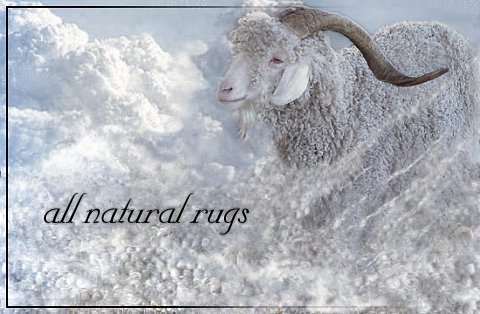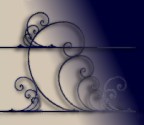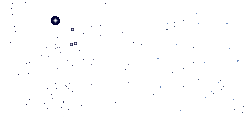Welcome to our rug weaving page.
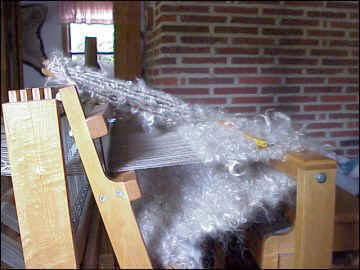
Side view illustrating the rich loft of our some of our rugs
Though mohair is noted for its elegant beauty, fiber textilists have long known of mohair's great durability. The turn of the century sported mohair cloth for all seats on trains, coaches and vehicles of every sort. This strong adult mohair fiber was used even in horse tack and the cinch girding horses to this day is called a "mohair", though few know from whence it derived its name. We craft long lasting rugs using linen warp to enable us to make them thick with the plush tendrils of mohair. The texture includes the natural locks which lace the entire surface. Our 3X5 foot prototype weighs five lbs.! The well distributed locks of hair naturally speak of a living fiber full of charm.
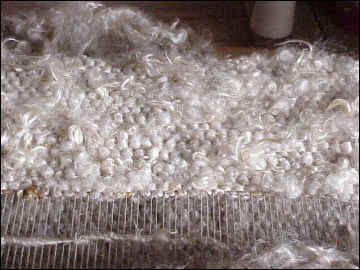
Custom woven: you choose the color, the size and the weave. We do the work.
Because of the rich texture and diversity of fleece personality, the rugs have become very popular. They have the ambiance of a Rya type rug but the character of a tanned hide (without all of the trouble the leather of a hide demands). Sometimes a customer asks for a more woven look, smoother in texture. That's what we do best here - custom design our rugs. Our customer dictates his/her preference and we weave to order. There are colors to choose from in natural mohair - silvers, golds, browns and of course, natural creamy white. Choose your color, choose your choice of weave. These rugs have the ability to take on and enhance a broad spectrum of decor styles. Mohair has a brilliant sheen and room lighting only enhances its beauty. Its main attribute is its elegant naturalness. Mohair does not have to compete with acrylic fibers now found in almost all area rugs. It is a fiber all its own, is amazingly easy to maintain (just vacuum on occasion) and takes a beating. You will not have to tiptoe around your mohair rug or hang it on your wall as an artistic accent. It is a rug that can be displayed proudly on your floor and walked on every day.
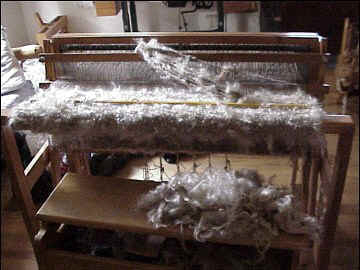
The web: a strong infrastructure of dense "cordage" is woven throughout.
Rich and dense, Alexandra spins her "cordage" for the rugs first. Cordage? That is a thick single ply yarn approximately 1/4 - 1/2 in diameter. Two main types of cordage are used. One is a smooth, strong yarn made from spun roving. Interlocked with the rug pile it is nearly imperceptible to the eye. The other type of cordage she spins is of long staple lustrous mohair, filled to the brim with tendrils (seen in foreground against the linen warp in this photo.) She weaves the cordage yarn around handfuls of unspun long staple fleece and the eventual rug is warm, lofty, and packed ever so tightly with lovely lustrous mohair.
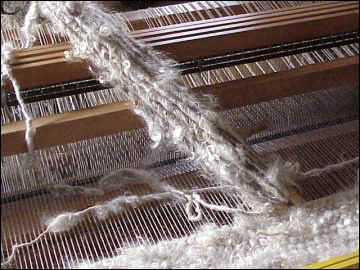
A close up of our "cordage" rug yarn wound on the stick shuttle. At times we receive requests from other weavers who want to attempt to weave a similar rug. We are happy to share anything we can to help them along.
Along with the strength of cordage yarn which interlocks the weaving, we incorporate very long stapled pile into the rugs. This is an important element that adds significantly to the making of the rug. (The longer staple helps to secure the mohair into the rug.) Mohair is not like wool. Very few scales appear on the goat hair shaft. Thus, its brilliance under light. Mohair is much stronger than wool (strand for strand, stronger than steel it is said) and quite able to withstand the rigors of human traffic. Also of great value is the imported Belgium Linen that makes up the warp. Linen is famous for enduring resistance to wear. Our warp is unbleached and matches mohair's longevity.
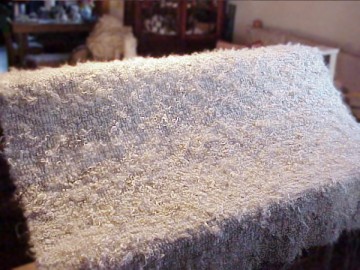
The White Hearth Rug (5x7) as viewed just off the loom.
When Alexandra has woven the rug, she then takes it off the loom and does the necessary finish work. She ties the linen ends securely and then trims the linen warp threads. Next comes the careful washing. Perhaps that question is the most asked by customers. How do I wash my rug? The good news is that most rugs can be put into the home washing machine and washed there. The agitation cycle is NEVER used. Rather, a gentle long soak in tepid water and suds is the way to keep your rug spanking new in looks. Washing instructions are always included with any rug order.
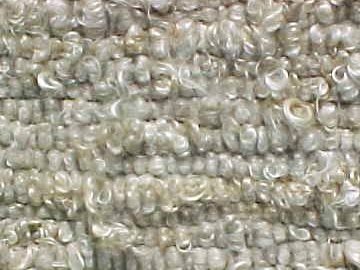
Thick durable mohair pile viewed from a very close proximity. What is especially noticed in this picture is mohair's sheen. Luster. You won't see this kind of brilliant gleam under light with any other fiber.
This close up camera view shows the intricate weave of one of our White Hearth Rugs. White seems to be the most popular color with gold and brown following closely behind. No one has yet ordered a silver/black rug, but we believe it would make a worthy, even regal colored rug. Weaving one of these rugs is not a fast process. You won't find any mechanized looms in this small cottage, and there are no employees, either, unless you would count the angora goats who give their fiber twice a year to the shearer. Depending on your choice of rug size, we select the proper sized loom. Then we go to our mohair warehouse (the second story of our barn.) There Alexandra takes her time to select only the best fleeces for her project. If there is too much debris, the fleece is not used. If the staple length of the fleece is insufficient, it is put aside. This is a one-of-a-kind weaving and not any fleece will do. Remember, no one will ever have a rug just like yours. The weave shown to the right is a smoother weave, one that customers often like best.
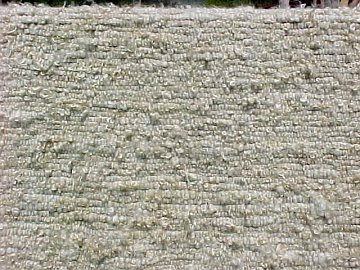
The above rug is shown here at a distance.
This rug was woven after one of my customers said that she did not want a shaggy mohair look. Her room decor was such that a more subdued look was best. She loved the idea of some of the mohair tendrils escaping from the weave, however. So, we settled on a compromise. Alexandra understood what her customer was envisioning and got to work. After our customer received the rug that crisp autumn day, she wrote immediately saying that we had gotten it just right! That's always the best part of this home business: pleasing our customers and making their dream for a perfect rug come to fruition.
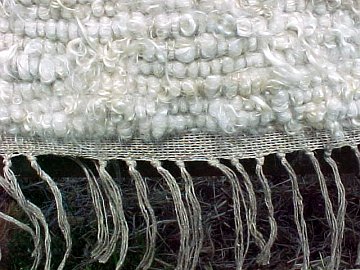
Linen reinforcement is woven before the mohair weave begins.
The photo to the right shows what either end of the mohair rug will look like after the completion of the rug weaving. Belgium linen has been our choice for warp, its strength and durability unsurpassed. It is more costly than other fibers, but it is a perfect companion to our mohair weft. Seen here is the strong linen reinforcement woven on both edges.
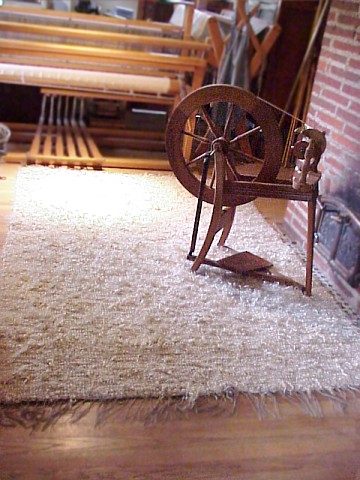
Our hearth rug
To the left is our own hearth rug before our bricked Russian Furnace. Mohair rugs look especially elegant atop hard wood flooring. An acquaintance who lives in Arizona says that many houses have tile floors. She mentions that where she lives, hand woven rugs like ours are especially coveted. The last rug I wove was 3x6 and went to San Antonio, Texas. My customer asked for golds and browns to fit her color scheme. I found the choicest of long, lofty mohair fleeces and even included some gorgeous golden colored kid fleeces. I then wove the shaggiest mohair rug I have ever woven and enjoyed every minute of my work. It took extra time selecting the right locks for the project, but it was well worth it in the end. The white rug shown here is 5x7, a bit larger than our small living room requires. Custom orders in custom sizes, not to mention custom colors, are always welcome.
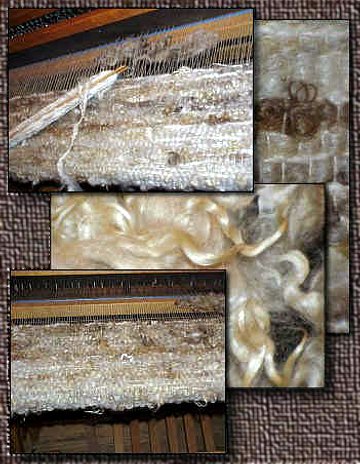
Brown and gold, shimmery mohair woven into a sturdy rug. No dyes, but the way nature made it.
A full spectrum of natural colors is available. Our angora goat herd ranges in color from black to white to red/brown with varying shades and blends of each including charcoal and silver. The collage to the right shows some of the red/brown color variations found in the fleeces of our angora goats. There are various subtle color tones that blend easily because quite often they come from the fleece of one animal which nature has inherently blessed with variegated hues. An example is this rug which was woven from Donna's fleece. Her mohair ranges from deep brown to shimmery gold. The weavings are just a couple of genteel steps up from a fleece shorn right off the goat and placed underfoot. We have done several specially custom designed large area rugs and your order is welcome.
Price Range:
- 38" x 60" (includes short fringed ends) = $450 + shipping
- 44" x 72" (includes short fringed ends) = $600 + shipping
- 58" x 84" (includes short fringed ends) = $750 + shipping
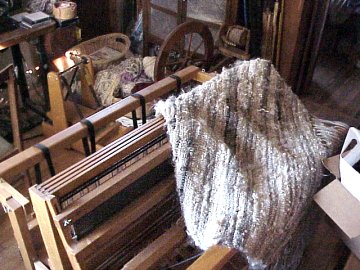
White mohair interlaced with bands of silver mohair, a dense, rich colored rug for under foot.
A fitting last photo, the rug pictured to the left is shown freshly off the loom. It was woven with natural colored silver mohair bands to accent the predominantly white background. "My loom is like a canvas," says Alexandra, "and our goat fleeces are like the paints." Because no fleece is ever a duplicate of another, no weaving is ever a duplicate of the last. Each is unique. None bear twins.
Top Back to gallery
